MM916 Project 1: Climate Change Analysis using R-Studio: Exploring Scenarios and Visualizations
Boost your grades with Assignment Help Online tailored for UK students. Our professional writers create original, high-quality assignments to meet strict university guidelines. Affordable and reliable, our service saves you time and stress. Get a free quote today and excel in your studies!
Introduction : Climate Change Scenario Analysis in R-Studio
Question 1.
(a). Here, the respective model scenarios have been taken into consideration. Two of the provided datasets are selected to perform the required objective on the aforementioned data. The data for the code is written on the R studio, and after that, the data analysis is also performed in this software to get the desired output.

Figure 1: Showing the years related to the models
The execution of the above-mentioned queries has taken place successfully, giving birth to the corresponding outputs.
_6603b0e3a273a.png)
Figure 2: The output table to display the start and the final year
The table displayed in the section above showcases all of the included years concerning the considered model scenario in particular (Deseret. al. 2020). The years have been showcased by way of the right-side column. This shows the total output of the years covered by the three model scenarios seriously from acceding to descending which is shown in the image in the above section.

Figure 3: The code from Tideverse
The above image is the total coding portion of the tideverse which is needed in this section of the project (Miralles et. al. 2019). The coding is done in the software called R-Studio. This image explains the coding portion of the tideverse.

Figure 4: Table containing 3 scenarios with the start and end year of each scenario
The above image explains and gives the start and end year of all three scenarios that have been taken into this project discussion. This is a table of all the 3 scenarios with the start and end year (Hoegh-Guldberg et. al. 2019). The table is created in the software called R Studio using the data set of extreme climate change.
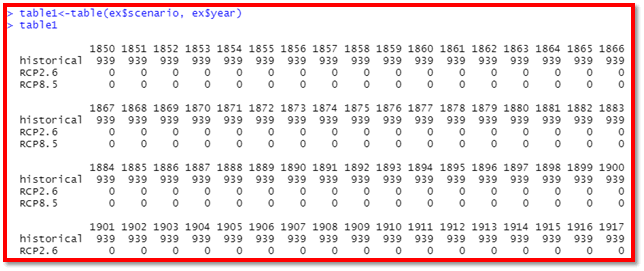
Figure 5: Table for 1st scenario
The following table is created to describe the 1st scenario from the ex-data frame and the data columns scenario and year is used to create the table.
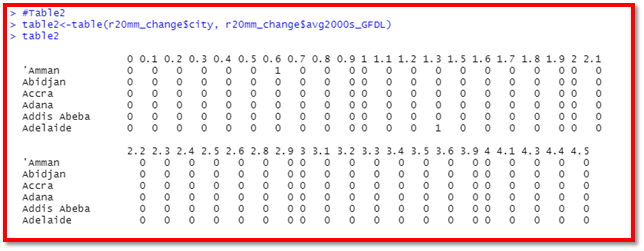
Figure 6: Table for 2nd scenario
The following table is created to describe the 2nd scenario from the r20mm_change, data frame and the data columns city and avg2000s_GFDL is used to create the table.
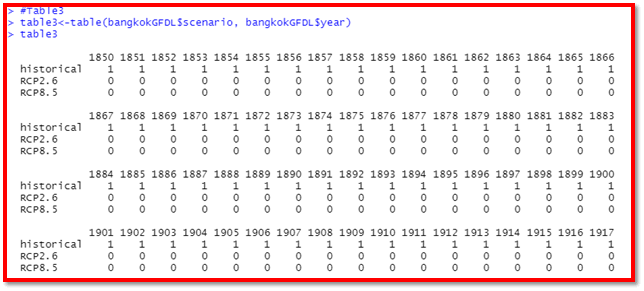
Figure 7: Table for 3rd scenario
The following table is created to describe the 3rd scenario from the bangkokGFDL, data frame and the data columns city and year are used to create the table.
(b). The queries within the below displayed the “bangkokGFDL” data frame to the data about the city of “Bangkok”.

Figure 8: Showcasing data about “Bangkok”

Figure 9: The output of the queries showcasing the data regarding Bangkok
The above picture gives the output of the results that have been obtained after executing the earlier queries in particular.
<pclass="heading">(c). In the below-given picture, this query considers the factor of displaying the entirety of the timeline for the city known as “Bangkok” in this case (Dusengeet. al. 2019). The dataset has also been incorporated within the query in question. The column d “wide” is considered for implementing the aforementioned query.

Figure 10: Query for executing the timeline factor

Figure 11: The coding portion of the Histogram representation for the Bangkok GFDL$wsdi
The above image is the total writing part of the coding section for creating a histogram representation for the Bangkok GFDL$wsdi. The coding portion is done in the software called R-Studio and after running or compiling the code the output of the code is generated which is a histogram plot for Bangkok GFDL$wsdi (Cattaneo et. al. 2019). In the below section, the image of the histogram output is given with an explanation of the image.
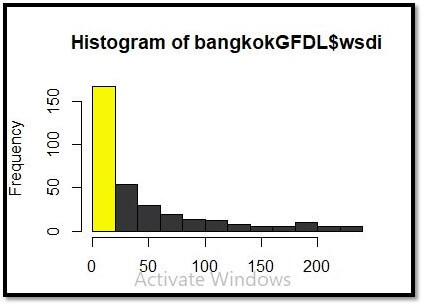
Figure 12: Histogram representation for the Bangkok GFDL$wsdi
The above image is the actual plot wsd1 for Bangkok in all 3 scenarios that have been taken into account for this project (Harvey et. al. 2020). The plot of the wsdi1 for Bangkok in case of the all 3 scenarios is represented in a histogram representation. The above image of the histogram explains all the necessary queries for the Bangkok GFDL$wsdi.
(d) Here, these queries have been executed to fulfil the objective of showcasing the overall distribution of the values about a specific column (Harvey et. al. 2020). A particular data set has been taken into account out of the three ones for generating the corresponding result for that matter.

Figure 13: Displaying the distribution of all the values
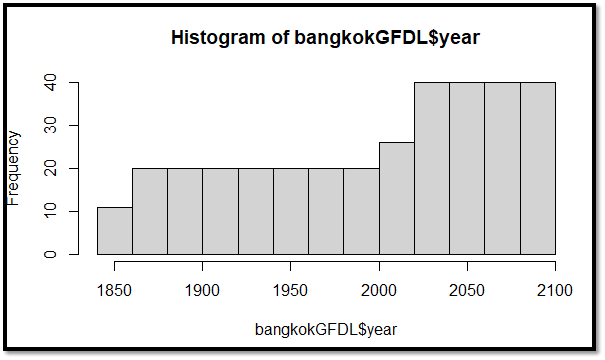
Figure 14: The output plot of the respective column
This image pertains to the output of the queries that have been mentioned in the earlier image in particular (Hoegh-Guldberget. al. 2019). The data that has been considered for generating the above plot comes from the column d “year” in this case. This plot is known as a “histogram plot”, consisting of several vertical bars placed adjacent to one another.
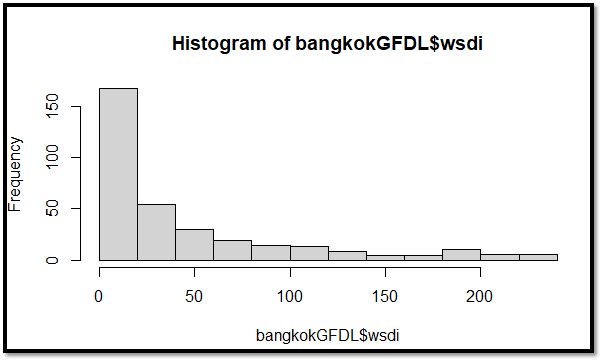
Figure 15: The output plot of the concerned column
This particular “histogram plot” has been obtained by executing the corresponding query on the column called “wsdi” (Jansson. al. 2020). Here, the “y-axis” represents the “frequency” of the numerous occurrences, and the “x-axis” showcases the data housed inside the aforementioned column. This curve showcases the fact that the value is coming down over the years. The value was very high in the past but the frequency of occurrence has come down in the present time.
A similar scenario has been taken into consideration by way of the image above, but a different dataset is selected to perform the operations in this regard (Krayenhoffet al. 2018). The columns have remained the same here, but the distinction lies in terms of the nature of incorporated data in this regard.
In the picture above, the column is “year” which has been showcased along the “y-axis”. Similarly, the “x-axis” represents the number of occurrences in particular. An upward movement has been witnessed from the nature of this curve. The amplitude of the individual bars has showcased the fact that there has been a sharp increase in climate change as far as the number of years is concerned.
Here, like in the earlier image, the same data set is used for producing the respective outcome, d “ex” (Miralles et. al. 2019). But the column along the “y-axis” d “wide” has been plotted in the form of a graph against the total number of occurrences. This curve displays the fact that the intensity of the aspect of climate change has come down over the years.
This above image is the coding portion for creating the plot containing wsdi with scenarios which is done in the software called R-Studio.
The above image is the Plot containing wsdi with scenarios clearly and this is the output for the coding portion that has been done in the R-Studio.
(e). Each of these earlier plots has provided the very foundation of how climate change occurs over time. The nature of these changes has stayed almost constant for years. As two of these plots have showcased the fact that climate change is rapidly increasing over the years, the other two have showcased the exact opposite of this scenario. One of the reasons for this is the incorporation of different columns to generate the outcome. To the aspect of climate change, it could very well be seen that the promises that were made in certain world forums have not been met properly as far as the degree of precision is concerned. It is quite natural to see that the number of harmful emissions is decreasing over time if any resolution has been taken up for the better. The degree of mitigation regarding the change would be gradual in manner, as a rapid decline in climate change is far from the reality.
Question 2
The respective functions have been created for the columns that have been mentioned in the questions, and the software platform of r-studio has been used to execute the necessary queries that would be in line with the functions in question. After the creation of these functions, the functions have been called at the proper place to execute the required results in this regard. The duration has been taken up in a matter of several years that were already given in the respective sets of data for that matter. It has been done with utmost accuracy and efficiency to the corresponding outcome in particular.
(a). The following function is to create to take the “ex” data frame as the input as return the output values.
(b). The modified function returns a useful error message if the specific city is not in the dataset.
(c). The following function takes the country and the number N as input and returns the appropriate type of variable.
(d). The following function is utilized to determine the projected annual high temperatures respectively.
Question 3
(a). The image in below showcases all of the respective queries that are instrumental in generating the corresponding scatterplot (O'Gorman et al. 2018). The function known as “ggplsot()” has been incorporated to generate the respective plot. The query for generating a blank map of the world is “ggplot () + borders ("world", fill="white", colour="gray80")” in this regard.
Figure 24: Queries for making the output plot
(b). This image represents all of the queries that have been used to generate the map of the world. The library known as “ggplot” has been incorporated into the platform to facilitate the aforementioned task in particular.
This picture is the output of the queries showcased by way of the earlier image. It is a blank map of the globe that has been generated by way of the query mentioned in the earlier section (Raza et al. 2019). All of the cities that consist of the whole of the considered dataset have been represented with the help of this image on the whole, without providing any specification. When it comes to the aspect of displaying any kind of world map, the latitude and the longitude also play a vital role in constructing the whole of the domain on which the specific areas will be showcased.
This picture has been attached above to display the outcome of the corresponding queries in a graphical manner. The colour of each of these dots has been mentioned in the right-hand side of the image. The “Sepal. Width” and “Sepal. Length” factors have been taken up along the “y”, and “x-axis” respectively.
This image displays the specific set of queries that have been executed properly to plot all of the cities included in the dataset on the entirety of the world map (Santamouris, 2020). In this query, it can be easily observed that several parameters and attributes have been incorporated in this regard. These are the “size”, “colour”, “scale”, and “identity” respectively. All of these factors give a brief description of the parameters considered for generating the corresponding outcome.
(c). This picture showcases the aspect of plotting the respective cities and other places for the world map created earlier. Here, the of a specific city has been included to point out its location on the map. All of these queries were run and executed suitably in this regard.
This image renders several insights regarding the necessary objectives that have been fulfilled through the generation of similar plots successfully. The two axes that make up the very foundation of similar types of graphs have also played a crucial role in this regard. The “latitude” and “longitude” have been taken into consideration while executing the queries showcased in the above plot in particular (Sharma et al. 2019). The “location” mark inside this image provides the details about the exact location where the respective cities are placed.
Conclusion
In this research, the platform of software known by the “R-Studio” has been used for the sole purpose of executing the respective codes along with obtaining the corresponding outcomes. The datasets are provided to meet all of the requirements without having to come across any errors for that matter. Each of the questions has been met properly without getting any errors in terms of the corresponding queries. The outcome of the query execution process has been showcased in the form of the respective plots. The histogram plot has been properly generated by executing the respective queries in general. The nature of the obtained plots is very crucial in providing the underlying conclusion in respect of the concerning question in general.
Reference list
Cattaneo, C., Beine, M., Fröhlich, C.J., Kniveton, D., Martinez-Zarzoso, I., Mastrorillo, M., Millock, K., Piguet, E. and Schraven, B., 2019. Human migration in the era of climate change.Review of Environmental Economics and Policy.
Deser, C., Lehner, F., Rodgers, K.B., Ault, T., Delworth, T.L., DiNezio, P.N., Fiore, A., Frankignoul, C., Fyfe, J.C., Horton, D.E. and Kay, J.E., 2020. Insights from Earth system model initial-condition large ensembles and future prospects.Nature Climate Change,10(4), pp.277-286.
Dusenge, M.E., Duarte, A.G. and Way, D.A., 2019. Plant carbon metabolism and climate change: elevated CO 2 and temperature impacts on photosynthesis, photorespiration and respiration.New Phytologist,221(1), pp.32-49.
Harvey, J.A., Heinen, R., Gols, R. and Thakur, M.P., 2020. Climate change‐mediated temperature extremes and insects: From outbreaks to breakdowns.Global change biology,26(12), pp.6685-6701.
Hoegh-Guldberg, O., Lovelock, C., Caldeira, K., Howard, J., Chopin, T. and Gaines, S., 2019. The ocean as a solution to climate change: Five opportunities for action.
Jansson, J.K. and Hofmockel, K.S., 2020. Soil microbiomes and climate change.Nature Reviews Microbiology,18(1), pp.35-46.
Krayenhoff, E.S., Moustaoui, M., Broadbent, A.M., Gupta, V. and Georgescu, M., 2018. Diurnal interaction between urban expansion, climate change and adaptation in US cities.Nature Climate Change,8(12), pp.1097-1103.
Miralles, D.G., Gentine, P., Seneviratne, S.I. and Teuling, A.J., 2019. Land–atmospheric feedbacks during droughts and heatwaves: state of the science and current challenges.Annals of the New York Academy of Sciences,1436(1), pp.19-35.
O'Gorman, P.A. and Dwyer, J.G., 2018. Using machine learning to parameterize moist convection: Potential for modeling of climate, climate change, and extreme events.Journal of Advances in Modeling Earth Systems,10(10), pp.2548-2563.
Raza, A., Razzaq, A., Mehmood, S.S., Zou, X., Zhang, X., Lv, Y. and Xu, J., 2019. Impact of climate change on crops adaptation and strategies to tackle its outcome: A review.Plants,8(2), p.34.
Santamouris, M., 2020. Recent progress on urban overheating and heat island research. Integrated assessment of the energy, environmental, vulnerability and health impact. Synergies with the global climate change.Energy and Buildings,207, p.109482.
Sharma, S., Blagrave, K., Magnuson, J.J., O’Reilly, C.M., Oliver, S., Batt, R.D., Magee, M.R., Straile, D., Weyhenmeyer, G.A., Winslow, L. and Woolway, R.I., 2019. Widespread loss of lake ice around the Northern Hemisphere in a warming world.Nature Climate Change,9(3), pp.227-231.



